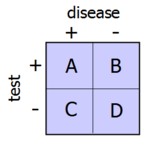
Sensitivity, Specificity, Positive & Negative Predictive Value
last authored: March 2010, David LaPierre
last reviewed:
Introduction

The positive predictive value (PPV) is one of the most important measures of a diagnostic test. It measuring the probability that a positive result is truly positive, or the proportion of patients with positive test results who are correctly diagnosed. It is also called the precision rate, or post-test probability.
Sensitivity is the ability of a test to find cases, and is represented by TP / (TP+FN).
Specificity is the ability of a test to avoid false positives and rule out disease, or TN / (FP+TN).
Positive predictive value (PPV) is the ability of the test to correctly label people who test positive, or A / (A+B)
Negative predictive value (NPV) is the ability to correctly label people who test negative, or D / (C+D)
A critical concept is that PPV depends on the prevalence of the disease. The rarer the condition, the more likely a negative test result is truly negative, and the less likely a positive test result is truly positive.
The Role of Prevalance
Prevalence, or the number of people in a population who have the condition at any one time, increases the PPV but decreases the NPV. As prevalence increases, A and C go up as B and D go down, with the opposite happening for decreased prevalence.
Prevalence has no effect on a test's sensitivity or specificity. These are not as useful measures when prevalence is quite low; PPV and NPV are more important.
Calculating the Positive Predictive Value
The PPV is a straightforward concept, but can be challenging at times as well. There are two ways of calculating the PPV:
- PPV = (# true positives) / (# true positives + # false positives)
- PPV = sensitivity x prevalence / sensitivity x prevalence + (1-sensitivity) x (1-prevalence)
exercise: positive predictive value and gonorrhea
Using Positive Predictive Value Wisely
Note that the PPV is not intrinsic to the test - it depends also on the prevalence. This means that published results may not apply given a clinical situation, with differing prevalence rates. If prevalence is very low, even if sensitivity and specificity are high, many positive test results will be false positives.
NPV and PPV should only be used if the prevalence of patients being evaluated is equivalent to the prevalence of the diseases in the reported population.
If it is not, positive and negative likehood ratios [positive LR = sensitivity/(1-specifity); negative LR = (1-sensitivity)/specifity] should be reported instead of NPV and PPV, as likelihood ratios do not depend on prevalence. The probability that a patient tests positive and truly has a condition, versus testing positive and not having the condition, is the likelihood ratio, and is calculated as sensitivity / (1-specificity). The LR indicates increasing certainty about a positive diagnosis.
Screening tests should be designed to dramatically improve the pre-test probability of a confirmatory test by enriching the prevalence in people being tested using the confirmatory test.
Likelihood Ratio
A l ikelihood ratio is the chance that a specified test result would be expected in a patient with the condition of interest, versus a patient without the condition.
In other words, the observed results are X times more likely to be seen in someone with, as opposed to without, the disease.
It is determined by [A / (A+C)] / [B / (B+D)], which is also [sensitivity / (1-specificity)]
Post-test probability (which is the same as PPV for dichotomous tests) can be determined using pre-test probability and a nomogram. Confidence intervals around the LR show are helpful and lead to a fairly broad range of possible post-test probabilities.
Resources and References
Altman DG, Bland JM. 1994. Statistics Notes: Diagnostic tests 2: predictive values BMJ. 309:102
to do: get picture of receiver-operator curve.
